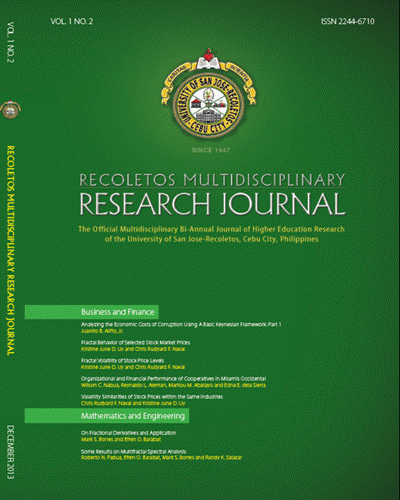A Fractal View on the Suicide Incidence of Countries
DOI:
https://doi.org/10.32871/rmrj1301.02.16Keywords:
suicide, suicide rate, fractal dimensionAbstract
Various studies on suicide and the reasons why people commit it across cultures have been conducted. However, a global view of the suicide rates, has not been explored yet. This study will prove helpful in understanding further the effect of specific cultural and social factors of the phenomenon using Fractal Statistics. This statistical method describes the irregularity of the variable. Its appropriateness is anchored on the fact that Fractal Statistics as a tool can measure the non-normal behaviour of a data set such as those found in the suicide incidence report. The data associated with female suicide do not differ
much from country to country. However, differences in the male suicide rate are immensely observable. Causes such as family breakdown, overwork, and employment security are identified. Yet, questions linger regarding this psychological “short circuitâ€, especially on the high incidence of suicide in the male population traceable to lack of cultural support and men’s unwillingness to talk about suicide..
References
Barabat, Borres et al. Some Results on Multifractal Spectral Analysis. 2013. Unpublished. Recoleto Multidisciplinary Journal, vol 2.
Borres, Barabat, et al. Societal Offenders in Prison: Global In-Country Analysis By Fractals. 2013. Unpublished. Recoleto Multidisciplinary Journal,
Vol 2.
Canadian Mental Health.“Suicideâ€. (2013) Chung, J. , et al (2010). The Cultural Theory and Model of Suicide. Applied and Preventive Psychology vol. 14 issues 1-4. June 2010, pp 25-40.
Dan Bilsker, Jennifer White. The Silent Epidemic of Male Suicide. BCMJ, vol. 53, no. 10, December 2011, pp.529-534. http://www.bcmj.org/articles/silent-epidemic-male-suicide http://www.annalsgeneral-psychiatry.com/content/12/1/21
Joiner, Thomas .â€The Interpersonal-Psychological Theory of Suicidal Behavior: Current Empirical Status. Psychological Science Agenda. June 2009.
Kim, Hyun-Chung. South Korea: Highest Suicide Rate DespitePercent Drops. http://www.euronews.com/2013/09/30/south-korea-highest-suiciderate-despite-11-percent-drop/
Kwanwoo, J.. Suicide Rates falls in Seoul but still Very High. http://blogs.wsj.com/korearealtime/2013/10/07/suicide-rate-falls-inseoul-but-still-very-high/
Padua, Barabat et al. Construction of a Simple Multifractal Spectrum as an Alternative to the Legendre Spectra in Multifractal Formalisms. 2013. Recoleto Multidisciplinary Journal, vol 1.
Rihmer, Z.,Gonda,X.,et al. Suicide in Hungary-Epidemiological and Clinical perspectives. Annals of General Psychiatry. 2013
Springen, Karen. Daring to Die: the Psychology of Suicide.2010. Scientific American.
World health Organization.Bulletin of the WHO- Women and Suicide in Rural China, 2009. Vol. 87.
Downloads
Published
How to Cite
Issue
Section
License
Copyright of the Journal belongs to the University of San Jose-Recoletos


